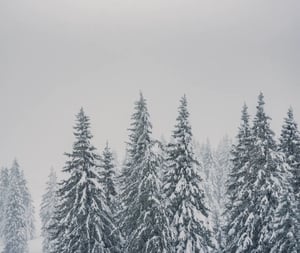Snow and ice storms can quickly create dangerous situations and cause major issues for homeowners. A blizzard can bring strong winds greater than 35 mph and reduce visibility to less than 1/4 of a mile. After a blizzard has passed, high winds can create whiteouts and snowdrifts.
These conditions can make travel impossible, leaving individuals stranded at home or in vehicles and sometimes without power or resources. Before you get caught off guard this winter, here’s how to prepare for a winter storm.
Featured Resource:
Winter Storm Prep: Emergency Checklist
Snow and ice storms can quickly create dangerous situations and cause major issues for homeowners. Stay safe with these action items.
How to Prepare for a Blizzard
From snow to ice to freezing and flooding, you should prepare your primary home and any secondary properties at risk of severe winter weather.
Have an Emergency Kit Ready
Your emergency kit should include:
- First aid items (bandages, antibacterial cream, gauze, etc.)
- Flashlights and batteries
- Manual can opener
- Water
- Snacks
- Cell phone and chargers
- Extra blankets and coats
- Salt and winter tools
Keep an Emergency Kit in Your Car, Too
Having an emergency kit in your car is essential in case of bad weather on the road. Things to keep in your car emergency kit:
- Water
- Snacks
- A cell phone charger
- Blankets
- Flashlight
- Jumper cables
- First aid kit
- Windshield scraper and shovel
Keep your car running well with routine maintenance. Fill up with gas and check the battery and tires before a storm hits.
Traveling during winter weather? Read our holiday travel safety guide here.
Stock Up on Non-Perishable Food and Water
Keep enough food and water for each person and pet in your family. The Weather Channel recommends at least three days’ worth. For water, that means about 3 gallons per person or pet.
Remember to include hygiene products, cleaning supplies, prescriptions, pet food, cat litter or doggie pads, baby formula, diapers, and wipes—whichever applies to you.
Seal Up Windows and Doors
Weatherize your home and yard before the winter season hits. Things like improving insulation in the attic, around doors, and windows can help keep more heat inside during a storm.
Before a storm, you can line doors and windows with rolled blankets or towels to keep out any cold drafts.
Bring Your Pets Inside
Whenever possible, bring your pets indoors to keep them warm and safe. If you can’t bring pets inside, they should have proper shelter and access to food and water that isn’t frozen. Snow fences can also clear paths by preventing snow drifts to barns or shelters.
Assess Your Home and Yard
Inspect your roof, gutters, and chimney before a winter storm. If you plan to use your chimney this winter to stay warm, have it cleaned and inspected before you use it. Stock up on wood at the start of the season.
Likewise, make sure your yard and any trees don’t pose any hazards to your home. If you have large branches or rotting trees that may damage your home or power lines during an ice storm, arrange for their trimming or removal in advance.
Winter Power Outage Tips
If you experience a bad winter storm, you could be stuck at home with no power for days. Knowing how to prepare and what to do could be lifesaving.
Even if you live in a warmer area, there’s still a chance cold weather could hit and cause problems, as seen with the Texas snowstorm of 2021.
Besides the above tips for winter storm prep, here’s what to do if you lose power:
Stock Up on Batteries and Flashlights
If the power goes out, you’ll need more lights and batteries to charge what you need. Battery-powered lanterns are great to have, too. Make sure you have these with your emergency kit.
Lower Your Refrigerator Temp
If power is likely to go out, lower your refrigerator temperature ahead of time. This will help keep your food cooler for longer.
Keep a Power Bank on Hand
A power bank can charge your phone when you don’t have power. Keep one or two of these fully charged and ready before a storm so you can charge your phone in case of emergencies. Also, if you’re able, you can charge your phone in your car with a car charger if the power is out.
Fill Your Bathtub
If your home uses an electric water pump, you’ll need extra water on hand for hygiene. Sanitize your bathtub and fill it with water if the power goes out.
Check on Your Neighbors
If you can, check in on your neighbors, family, and friends, especially those with young children or the elderly. They are especially at risk during snow storms and may need help.
Cold Weather Precautions
You must watch out for more than snow and ice: extreme cold temperatures are just as dangerous. Extreme temperature drops and winter storms can increase the risks of frostbite, hypothermia, and accidents. They can also increase the chance of damage to your home and pipes.
Follow these winter safety tips to prevent damage to your home and protect yourself in extreme cold:
Prevent Frozen Pipes
If the temperature drops below freezing for an extended period of time, pay attention to your pipes. The water in the pipes could freeze, cutting off your water supply and risking damage to your pipes. Then, when the water thaws, it may cause the pipes to burst and flood your home.
Here’s how to prevent this from happening:
- Know where your water shut-off valve is located.
- Insulate your water pipes in unfinished areas such as basements and garages.
- Set your thermostat to a warmer temperature. If possible, try to keep your home temperature at 65 degrees or higher. If your home is unoccupied, it needs to be 55 degrees or warmer.
- Turn off the water to the exterior hose bibs.
- Keep cabinet doors open to allow warm air to circulate near the pipes, such as under the kitchen and bathroom sinks. Move any chemicals and harmful items so children and pets can’t get to them.
- Allow the faucet to drip overnight to keep water moving and prevent freezing.
- Consider a low-temperature alarm. It will notify you and your alarm monitoring company when temperatures in your home drop to dangerous levels.
Prevent Ice Dams
Ice dams occur when snow on the roof goes through a cycle of melting and freezing. This can cause interior water damage to your attic and interior walls and ceilings.
Here are the steps you should take before a winter storm to prevent damage:
- Insulate your attic to prevent heat from rising to the shingles above.
- Clean your gutters. Clogged gutters can create ice dams, so keep them clear of debris.
- Make sure your gutters and downspouts are flowing properly. The downspouts should point away from your home's foundation.
Heat Your Home Safely
When it’s extremely cold outside, or the power goes out, you may need to use a space heater, generator, or fireplace. These need to be properly used, or they can pose a severe risk.
Some best practices to stay warm:
- Conserve heat. Close curtains over windows and close doors to rooms you don’t need.
- Generators should never be inside or too close to your home, as they can cause carbon monoxide poisoning. Keep generators at least 20 feet from vents, windows, or doors sheltered from rain and snow.
- Do not leave any candles unattended.
- Make sure your chimney is clean and inspected for safety before use, and only use dry firewood. If you have a gas fireplace, make sure it’s properly ventilated.
- Install a carbon monoxide detector. According to Weather.gov, CO poisoning claims 1,000 lives every year in the US, especially during winter months. These can be lifesaving!
- Never plug a space heater into an extension outlet. Space heaters are high voltage and could spark and cause a fire. Instead, plug them directly into the wall socket.
- Keep yourself and your family warm by dressing in layers and using extra blankets. Babies who are too young to have soft bedding or wear loose clothing in their cribs should be dressed warmer in footed pajamas and sleep sacks.
Reduce Your Risks and Stay Safe
At Vault, we know risk education and mitigation are key to reducing the severity of loss. Protecting your assets is more than insuring them. It’s looking at the bigger picture to reduce all possible risks. We provide all-encompassing risk management services to help proactively safeguard the life you’ve built – that’s the Vault difference.
Our Claims team is standing by and ready to assist 24/7. They can be reached at 1-844-388-LOSS (5677) or ClaimsFNOL@vault.insurance .
Request a quote and experience the Vault difference.
Related Products: Homeowners Insurance
Featured Resource:
Winter Storm Prep: Emergency Checklist
Snow and ice storms can create dangerous situations quickly, causing major issues for homeowners. Stay safe with these action items:
While Vault believes the information provided in this article to be accurate, we do not warrant the accuracy or reliability of the information provided. Vault is not responsible for, and does not adopt, endorse or approve any third-party webpages, or their content, that may be hyperlinked from this page. Nothing on this page alters any terms or conditions of an insurance policy and is not intended to be taken as legal, medical, or other professional advice.

